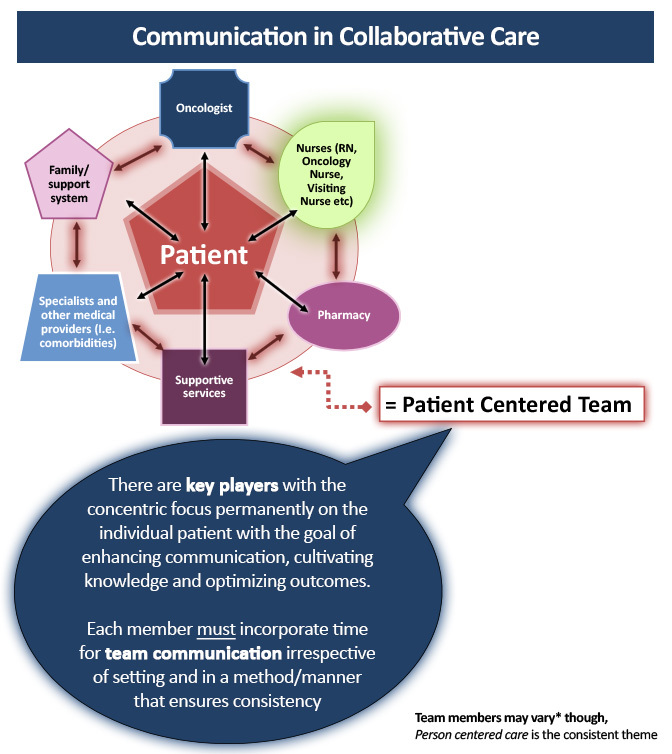Shared Decision Making
Shared Decision-Making
Shared decision-making (SDM) involves the bidirectional flow of information between healthcare providers and patients to ensure improved outcomes that align with a patient’s values and goals. The process involves the clear presentation of screening, diagnosis, and treatment options by the healthcare provider and a frank discussion about the patient’s thoughts and opinions before a joint decision is made on how to progress. Shared decision-making is distinct from informed decision-making, in which a patient is given information about treatment options and makes a unilateral decision on how to proceed. Shared decision-making operates under the following two premises:
- Patients informed of choices and adequate information will participate in medical decision-making by asking questions and expressing their personal values.
- Healthcare professionals will respect a patient’s personal goals and preferences and use them to guide recommendation and treatments.1
In 2001, the Institute of Medicine (IOM) published a report that proposed patient-centered care and shared decision-making as future tenets of medical care in the United States. The IOM recommended that care should be “respectful of and responsive to individual patient preferences, needs, and values” and emphasized the importance of making sure that “patient values guide all clinical decisions.”2 Not all healthcare decisions require SDM, particularly when there is one clearly superior path of care. For example, a broken bone must be set, and antibiotics are necessary for bacterial meningitis. However, there are many options for the screening and treatment of breast cancer that may affect a patient’s quality of life, and it is imperative that a patient’s personal preferences be included in all decision-making.
An early multiyear study of patients and families identified eight characteristics of care as the most important indicators of quality and safety from the patients’ perspectives, including3:
- Respect for the patient’s values, preferences, and expressed needs
- Coordinated and integrated care
- Clear, high-quality information and education for the patient and family
- Physical comfort, including pain management
- Emotional support and alleviation of fear and anxiety
- Involvement of family and friends, when desired
- Continuity of care, including care-site transitions
- Access to care
Informed patients are empowered with the information needed to play an active role in healthcare decisions. Although some patients prefer a less active role in medical decisions, evidence shows that many patients prefer to engage in SDM.
Decision Aids
Decision aids help raise patients’ awareness and understanding of their medical options and possible outcomes. They help patients understand the risks and benefits of complex decisions and enable them to communicate informed preferences. Good decision aids are balanced and do not promote one treatment over another. Decisions aids may be web-, paper- or video-based and may be used before, during, or after a medical-care visit.
A good decision aid will have the following characteristics4:
- Informs patients with organized, credible, and unbiased information
- Discusses credible resources and outlets
- Discusses risks and benefits (including the option of no treatment, when applicable)
- Allows the patient to make an informed decision
In a large Cochrane review, the use of decision aids for personal medical decisions led to5:
- Increased patient knowledge
- More accurate risk perceptions
- A greater number of decisions consistent with patients’ values
- Reduced levels of internal conflicts for patients
- A positive effect on clinician-patient communication
- Fewer patients remaining passive or undecided
Additionally, decision aids may address problems with overdiagnosis and overtreatment. Patients who were given decision aids were more likely to choose prostate-specific-antigen tests for prostate cancer screening and were less likely to choose major elective surgeries.
Implementing Shared Decision-Making
Although there is a lot of talk about patient-centered care in health care, there are still significant challenges in turning this goal into a reality. Patients should be educated about their role in decision-making and given information and aids to help them make informed decisions. They should receive the emotional support necessary to express their preferences and feel free to ask questions. The significant barriers in implementing SDM include3:
- Clinicians must be trained to become effective partners and ask patients about their values
- Difficulty in finding an accurate, up-to-date decision aid for patients
- Time pressure within a medical care visit
- Clinicians’ negative opinions about SDM and its perceived outcomes
- Patient factors, such as lack of trust, fear, poor literacy
- Decision aids must be tailored to a patient’s literacy level.
However, the benefits of SDM greatly outweigh the barriers to its implementation. Studies of SDM have shown the following benefits1:
- Increased patient satisfaction and confidence
- Better health outcomes
- Decreased anxiety and depression
- Improved quality of life
- Quicker recovery
- Increased compliance with treatment regimens
- Lower demand for healthcare resources
- Improved communication between healthcare providers and patients
- Enhanced job-related satisfaction among providers
The Informed Medical Decisions Foundation has developed six key steps to be used in all shared decision-making conversations.6
- Invite the patient to participate
- Present the options to the patient
- Provide information on benefits and risks
- Assist patients in evaluating options based on their goals and concerns
- Facilitate deliberation and decision-making
- Assist patientsin following through on their screening and treatment decisions

Role of the Oncology Nurse in SDM
Oncology nurses play a significant role in patient education and facilitate open communication about patient concerns. Some of the ways an oncology nurse can facilitate SDM include:
- Addressing patient concerns about care
- Reviewing patient preferences
- Providing education to the patient about the disease process
- Reviewing treatment options and issues
- Addressing and identifying side effects of specific treatments
- Managing patients on various treatments
- Creating a team environment for care
- Encouraging patients to report side effects and concerns
References
- Agency for Healthcare Research and Quality (AHRQ). Strategy 6I: shared decision-making. Available at ahrq.gov/sites/default/files/wysiwyg/cahps/quality-improvement/improvement-guide/6-strategies-for-improving/communication/cahps-strategy-section-6-i.pdf
- National Research Council. Crossing the Quality Chasm: a New Health System for the 21stCentury. Washington DC: National Academies Press; 2001. Available at nap.edu/catalog/10027/crossing-the-quality-chasm-a-new-health-system-for-the
- Barry MJ, Edgman-Levitan S. Shared decision-making—the pinnacle of patient-centered care. N Engl J Med. 2012;366:780-781.
- Schrager SB, Phillips G, Burnside E. A simple approach to shared decision making in cancer screening. Fam PractManag. 2017;24:5-10.
- Stacey D, Bennett CL, Barry MJ, et al. Decision aids for people facing health treatment or screening decisions. Cochrane Database Syst Rev. 2011;10:CD001431.
- Healthwise and the Informed Medical Decisions Foundation. The six steps of shared decision making. http://cdn-www.informedmedicaldecisions.org/imdfdocs/SixStepsSDM_brochure.pdf
